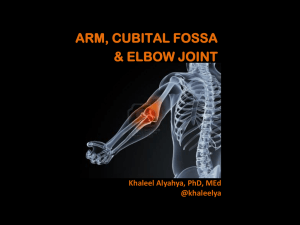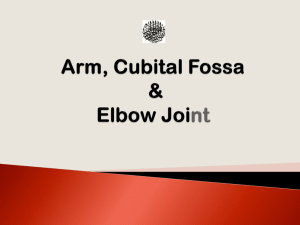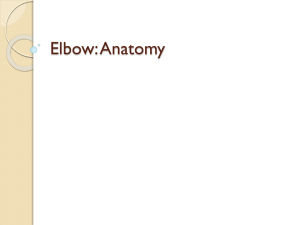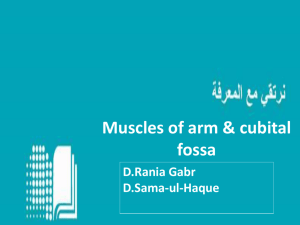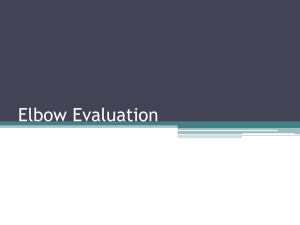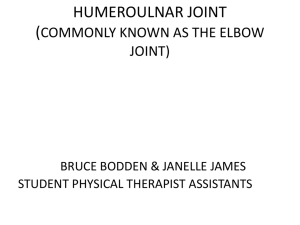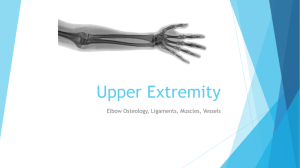ELBOW Joint
advertisement
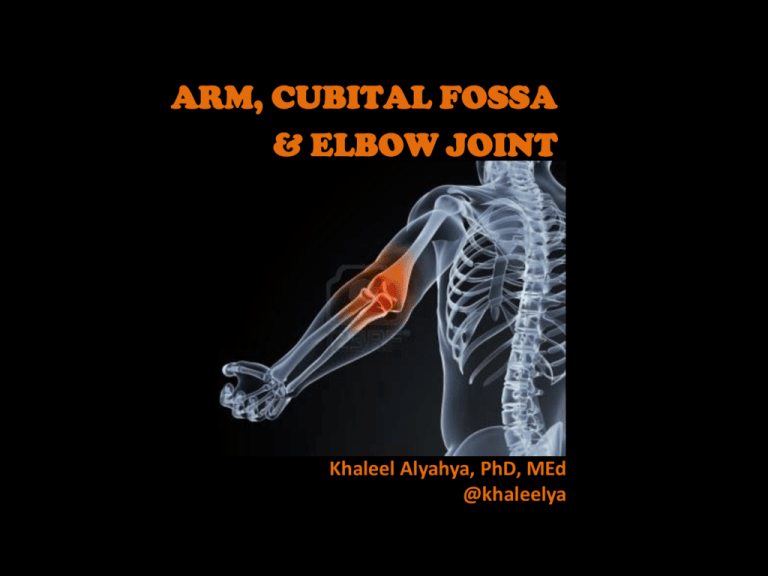
ARM, CUBITAL FOSSA & ELBOW JOINT Khaleel Alyahya, PhD, MEd @khaleelya OBJECTIVES At the end of the lecture, students should: Describe the attachments, actions and innervations of: Biceps brachii Coracobrachialis Brachialis Triceps brachii Demonstrate the following features of the elbow joint: Articulating bones Capsule Lateral & medial collateral ligaments Synovial membrane Demonstrate the movements; flexion and extension of the elbow. List the main muscles producing the above movements. Define the boundaries of the cubital fossa and enumerate its contents. The ARM A R M Shoulder Posterior view Anterior view Elbow Arm Humerus The ARM Septum is an aponeurotic sheet Lateral Medial intermuscular intermuscular separating various muscles of the septum septum extremities, including lateral and medial humeral septa. Neurovascular The lateral and medial skin bundle intermuscular septa divide the Fascia distal part of the arm into two Humerus compartments: Anterior Posterior Anterior Fascial Compartment Contents Muscles: Biceps brachii, Coracobrachialis &Brachialis. Blood Vessels: Brachial artery & Basilic vein. Nerves: Musculocutaneous & Median Muscles of the Anterior Compartment Coracobrachialis Biceps brachii Brachialis Biceps Brachii Coracoid Process Origin: Two heads: Long Head from supraglenoid tubercle of scapula (intracapsular) Short Head from the tip of coracoid process of scapula The two heads join in the middle of the arm Insertion: In the posterior part of the radial tuberosity. Into the deep fascia of the medial aspect of the forearm through bicipital aponeurosis. Biceps Brachii Biceps brachii Nerve supply: Musculocutaneous Action: Strong supinator of the forearm used in screwing. Powerful flexor of elbow Weak flexor of shoulder Tendon inserted to radial tuberosity Bicipital aponeurosis Coracobrachialis Origin: Tip of the coracoid process Insertion: Middle of the medial side of the shaft of the humerus Nerve supply: Musculocutaneous Action: Flexor Weak adductor of the arm Brachialis Origin: Front of the lower half of humerus Insertion: Anterior surface of coronoid process of ulna Nerve supply: Musculocutaneous & Radial Action: Strong flexor of the forearm Posterior Fascial Compartment Contents Muscles: Triceps Vessels: Profunda brachii & Ulnar collateral arteries Nerves: Radial & Ulnar Muscles of the Posterior Compartment Triceps brachii Triceps Origin: Three heads: Long Head from infrglenoid tubercle of the scapula Lateral Head from the upper half of the posterior surface of the shaft of humerus above the spiral groove Medial Head from the lower half of the posterior surface of the shaft of humerus below the spiral groove Insertion: Common tendon inserted into the upper surface of the olecranon process of ulna Nerve supply: Radial nerve Action: Strong extensor of the elbow joint Cubital Fossa The cubital fossa is a triangular depression that lies in front of the elbow Boundaries of Cubital Fossa Base: Line drawn through the two epicondyles of humerus Laterally: Brachioradialis Medially: Pronator teres Roof: Skin, superficial & deep fascia and bicipital aponeurosis Floor: Brachialis medially and supinator laterally. Content of Cubital Fossa (From medial to lateral side) 3. Biceps brachii tendon 1. Median nerve 4. Deep branch of radial nerve 2. Brachial artery divides into radial & ulnar arteries. Ulnar artery Radial artery ELBOW Joint Uniaxial, Synovial Hinge joint Articulation Trochlea and capitulum of the humerus above Trochlear notch of ulna and the head of radius below ELBOW Joint The articular surfaces are covered with articular (hyaline) cartilage. Capitulum Trochlea Capsule Anteriorly: attached Above To the humerus along the upper margins of the coronoid and radial fossae and to the front of the medial and lateral epicondyles. Below To the margin of the coronoid process of the ulna and to the anular ligament, which surrounds the head of the radius. Capsule Posteriorly: attached Above To the margins of the olecranon fossa of the humerus. Below To the upper margin and sides of the olecranon process of the ulna and to the anular ligament. Ligaments Lateral (radial collateral) ligament Triangular in shape: Apex Attached to the lateral epicondyle of humerus Base Attached to the upper margin of annular ligament. Ligaments Medial (ulnar collateral) ligament Anterior strong cord-like band: Between medial epicondyle and the coronoid process of ulna Posterior weaker fan-like band: Between medial epicondyle and the olecranon process of ulna Transverse band: Passes between the anterior and posterior bands Synovial Membrane This lines the capsule and covers fatty pads in the floors of the coronoid, radial, and olecranon fossae. Is continuous below with synovial membrane of the superior radioulnar joint Relations Anterior: Brachialis Tendon of biceps Median nerve Brachial artery Posterior: Triceps muscle Lateral: Common extensor tendon The supinator Medial: Ulnar nerve Bursae around the elbow joint: Subcutaneous olecranon bursa Subtendinous olecranon bursa Movements Flexion Is limited by the anterior surfaces of the forearm and arm coming into contact. Extension Is limited by the tension of the anterior ligament and the brachialis muscle. The joint is supplied by branches from the: Median Ulnar Musculocutaneous Radial nerves Carrying Angle Angle Between the long axis of the extended forearm and the long axis of the arm Opens Laterally About 170 degrees in male and 167 degrees in females Disappears When the elbow joint is flexed Permits The forearms to clear the hips in swinging movements during walking, and is important when carrying objects 1650-1700 Articulations The elbow joint is stable because of the: Wrench-shaped articular surface of the olecranon and the pulley-shaped trochlea of the humerus Strong medial and lateral ligaments. Elbow dislocations are common & most are posterior. Posterior dislocation usually follows falling on the outstretched hand. Posterior dislocations of the joint are common in children because the parts of the bones that stabilize the joint are incompletely developed. ELBOW Joint Avulsion of the epiphysis of the medial epicondyle is also common in childhood because the medial ligament is much stronger than the bond of union between the epiphysis and the diaphysis. QUEST!ONS?
